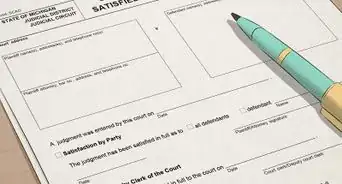This article was written by Jennifer Mueller, JD. Jennifer Mueller is an in-house legal expert at wikiHow. Jennifer reviews, fact-checks, and evaluates wikiHow's legal content to ensure thoroughness and accuracy. She received her JD from Indiana University Maurer School of Law in 2006.
wikiHow marks an article as reader-approved once it receives enough positive feedback. In this case, 82% of readers who voted found the article helpful, earning it our reader-approved status.
This article has been viewed 93,327 times.
If you believe a judge has violated the judicial code of conduct, you can file a complaint – with the judicial district for federal judges, or with your state's board or commission for judicial conduct for state or local judges – and have the situation investigated or reviewed. Complaints about a judge are not appropriate if you disagree with the judge's decision, or are upset because you lost a case. Rather, these complaints must be based on a specific violation of the rules governing judicial conduct, such as accepting bribes or engaging in partisan political activity.[1]
Steps
Drafting Your Complaint
-
1Get a complaint form. Each court system has a complaint form that can be used to file a complaint against a judge for conduct that violates judicial codes. Typically you can download a form online or ask the clerk of the court.[2] [3]
- In federal courts, you can find the form on the website of the district in which the judge serves.
- Judicial conduct complaints in state court systems typically are handled by a judicial conduct commission.
- You can find information about the commission, as well as complaint forms, by visiting the state court system website.
- You also may want to ask the clerk of court for information on how to file a complaint against a judge. They can help you get the forms you need as well as instructions on how to proceed with your complaint.
-
2Read the judicial conduct rules. The judicial conduct rules applicable to the judge about whom you want to complain set forth the reasons you may file a complaint against a judge, as well as the specific procedure for reviewing those complaints.[4] [5]
- This complaint process is not designed for situations where you disagree with the judge's ruling – the council or commission that evaluates these complaints is not an appellate court.
- While the judge's conduct may relate directly to a lawsuit in which you were a party, and may even have impacted the decision, your complaint is not with the decision itself.
- You can read the rules to find behavior that violates the code of judicial conduct. If the judge did any of those things, a complaint is proper.
- Some examples of conduct that violates the judicial code are judges who accept bribes to rule a particular way in a case, or judges who discriminate against you on the basis of a legally protected characteristic such as race or religion.
- The judicial code also has rules that describe the process to complain about a judge. You can read these rules, but you may be able to find instructions or a summary on the court's website that explains the process in plain language that's easier to understand.
Advertisement -
3Enter information about yourself and the judge. The first part of the complaint form generally requires you to provide information about yourself, the judge, and the case during which the misconduct you're reporting occurred.[6]
- Generally, you'll need to provide your full legal name and contact information, including your address and phone number.
- You must identify the judge by name and list the court over which that judge presides.
- If the conduct occurred during a lawsuit to which you were a party, you should list the title of that case and the case number. You can find this information in the caption, which appears on the top of the first page of any document filed in the case.
-
4Write your statement of facts. The second part of the complaint form requires you to describe the events that you believe constitute misconduct on the part of the judge in narrative form. Stick closely to the facts, and include as many details as possible.[7] [8]
- Provide the events or a description of the judge's behavior in short paragraphs, avoiding adjectives or embellishment. The officials who review the complaint are interested in a cold, straightforward account of the conduct at issue – not your personal feelings, judgments, or conclusions.
- For example, rather than saying "the judge was rude," you want to describe exactly what the judge said that you believed was rude. The conclusion that the judge's statements were rude is for the officials reviewing your complaint to find.
- Include as many factual details as you can, such as the date and time of particular instances of conduct. Generally, you want to present your statement in chronological order so the officials reviewing your complaint can follow the chain of events.
-
5Sign and date your complaint. Read over everything you've included in your complaint before you sign it. Proofread carefully and make sure everything is accurate, as when you sign the complaint you are doing so under oath.[9] [10]
- Complaints cannot be made anonymously. You may be called on to testify if charges of misconduct are filed against the judge.
Submitting Your Complaint
-
1Make copies of your complaint. The judicial conduct rules will specify how many copies of your complaint you need to submit to the court or commission. In addition to the copies you have to submit, you should make at least one copy of your signed complaint for your own records.
- If the complaint is being reviewed by a commission or board consisting of several members, you typically must submit a copy for each of those members in addition to your original.
- Each complaint typically must be in its own envelope, labeled "Misconduct Complaint" or similar on the outside. Don't put any other information, such as the name of the judge, on those envelopes.
- The judicial conduct rules or the instructions that accompanied the complaint form will tell you how to prepare your original complaint and copies for submission. Follow those steps exactly or your complaint may not be reviewed.
-
2Mail your complaint to the appropriate office. The judicial conduct rules or the instructions accompanying the complaint form provide the location where you'll need to submit your complaint for review.[11]
- If you were required to put each copy in an envelope, you'll have to find a larger envelope suitable for mailing in which to place them.
- You may want to mail your complaint in a method that allows you to track it so you know when it is received, but this is typically not required by the rules.
- You also may have the option of taking your sealed complaint to the office in person and handing it to the clerk.
- There is no fee to file a complaint about a judge in either state or federal court.
-
3Receive notice of the decision. Once your complaint is reviewed, you typically will receive an initial notice letting you know if further investigation will take place or if charges of misconduct will be filed by the reviewing judge or commission.[12] [13]
- The initial proceedings of the officials reviewing your application typically are private and confidential. You may receive a copy of any report completed if they investigate your complaint, but there's typically no requirement that they do so.
- Depending on the way the board or commission is organized, they may vote to conduct additional investigation before coming to a decision.
- While timeframes vary greatly depending on the location of the court and the content of your complaint, you shouldn't expect to hear anything regarding a decision for several weeks, if not months.
-
4Testify at the hearing. If misconduct charges are filed against the judge about whom you complained, you may be called to testify at the hearing. If so, you will be served with a subpoena and may be contacted by the prosecuting attorney.[14]
- Particularly in state courts, the board or commission reviewing your complaint typically will vote on whether to investigate the conduct you reported.
- After the results of that investigation are presented, they'll decide whether to file formal charges against the judge.
- While the initial proceedings of the board or commission typically are confidential and closed, if misconduct charges are filed the entire record, including your complaint, will become a matter of public record.
- Misconduct hearings typically are run very similar to a regular trial, but you are not a party to the case – even though you filed the initial complaint. Charges are filed by the board or commission that reviewed and investigated the complaint.
- Your role in the proceedings will be as a witness, testifying regarding the conduct you observed.
Petitioning for Review
-
1Receive a letter of dismissal. If you filed a complaint about a federal judge and the chief judge who reviews your complaint dismisses it, you will be sent a letter notifying you that your complaint has been dismissed.
- If an investigation is ordered and the special committee who completes the investigation declines to file charges of misconduct or begin impeachment proceedings against the judge, you'll receive notice of that as well.
- The letter typically will provide the reasons for dismissing your complaint. You should review these reasons carefully and make sure you understand them.
- If the reasons are related to an error you made in your complaint, you may be able to note that error and correct it when you petition for review.
-
2Draft your petition. If you want the circuit judicial council to review the chief judge's ruling, you must send a letter to the circuit judicial council requesting review within 35 days of the date you receive notice of the chief judge's dismissal.
- You have 63 days to petition a decision made by a judicial council after an investigation.
- Write your petition using a standard business letter format. You can find a template on any word processing application.
- Address your letter to the circuit clerk, and begin the first line of your letter with the words "I hereby petition the judicial council for review of ...."
- Provide information about your original complaint and the previous review it has received. Then explain why you believe that decision was wrong.
- When you finish your letter, proofread it carefully before you print and sign it. After you've signed it, make at least one copy for your records.
-
3Submit your petition. Your petition must be sent to the circuit court clerk of the circuit where the judge sits. There is no way to electronically file these petitions; they must be mailed. Put your letter in a sealed envelope marked "Misconduct Petition," then put that envelope in another envelope suitable for mailing.
- Make sure you don't include any other information, particularly the judge's name, on the outside of the sealed envelope that contains your petition.
- You can find the correct address for the circuit court clerk by going to the website for the circuit where the judge sits.
- Although there's no requirement that you use any particular mailing method, you may want to send your petition in such a way that you can track it and know when it is received.
-
4Wait for an order on your petition. Once your petition is received, the judicial council for that circuit will review and act on it. You will receive a copy of the judicial council's order on your petition, which also will be publicly available in the court clerk's office.
- If the order affirms the previous ruling and there is no dissenting opinion, the decision is final and you have no further means of appeal.
- If a member of the council dissented, you have the right to send a request to the Judicial Conference Committee on Judicial Conduct and Disability. The conference will evaluate your complaint and determine whether a special committee should investigate.
References
- ↑ https://www.tncourts.gov/boards-commissions/court-judiciary/file-complaint
- ↑ http://courts.ky.gov/commissionscommittees/JCC/Pages/FAQs.aspx
- ↑ http://www.law.uh.edu/libraries/ethics/judicial/complaints/index.html
- ↑ https://www.tncourts.gov/boards-commissions/court-judiciary/file-complaint
- ↑ http://courts.ky.gov/commissionscommittees/JCC/Pages/FAQs.aspx
- ↑ http://www.vawd.uscourts.gov/media/9702/judicialcomplaintform.pdf
- ↑ http://www.vawd.uscourts.gov/media/9702/judicialcomplaintform.pdf
- ↑ http://www.law.uh.edu/libraries/ethics/judicial/complaints/index.html
- ↑ http://www.vawd.uscourts.gov/media/9702/judicialcomplaintform.pdf
- ↑ http://www.law.uh.edu/libraries/ethics/judicial/complaints/index.html
- ↑ http://www.law.uh.edu/libraries/ethics/judicial/complaints/index.html
- ↑ http://www.law.uh.edu/libraries/ethics/judicial/complaints/index.html
- ↑ http://courts.ky.gov/commissionscommittees/JCC/Pages/FAQs.aspx
- ↑ http://www.law.uh.edu/libraries/ethics/judicial/complaints/index.html
About This Article
To complain about a judge, you’ll need to get a complaint form from your district website or the judicial conduct commission in your state. Make sure you read the judicial conduct rules for your court to determine which rule they broke. Then, fill in your form with details about the judge, the case, and their misconduct. When you write your statement of facts for the second part of the form, provide a factual description of the judge’s behavior. Avoid using adjectives or embellishments, like “The judge was unimaginably disrespectful,” since this can make your claim seem less professional. Instead, state exactly what the judge said or did, and allow the officials to draw their own conclusions. When you’ve finished the form, make as many copies as the conduct rules specify. Then, mail a copy to the relevant office. For more tips from our Legal co-author, including how to petition for review if your complaint is dismissed, read on.


-Step-1.webp)







































































